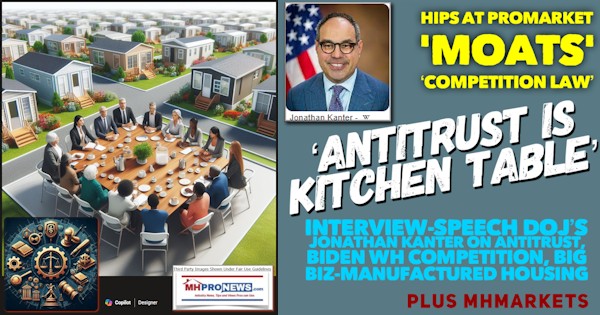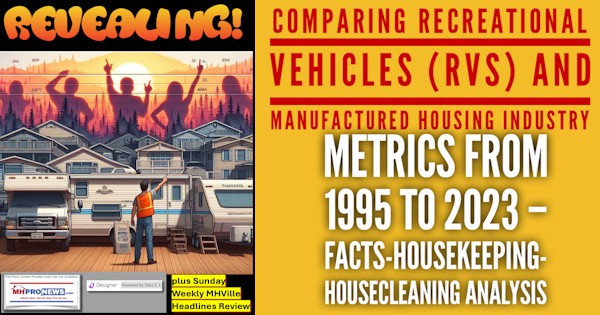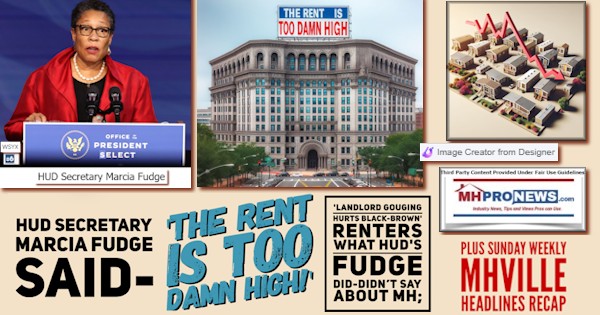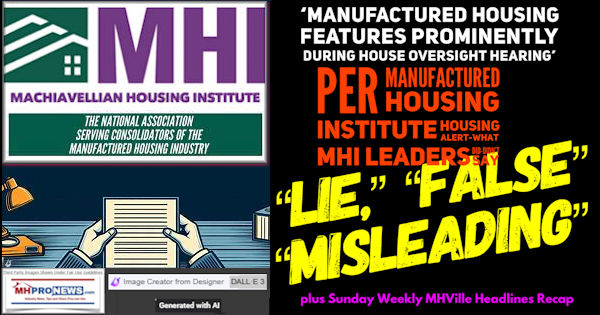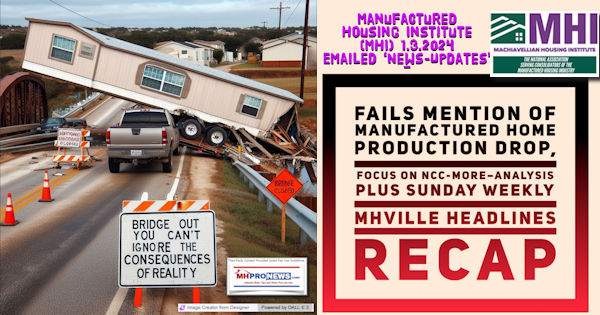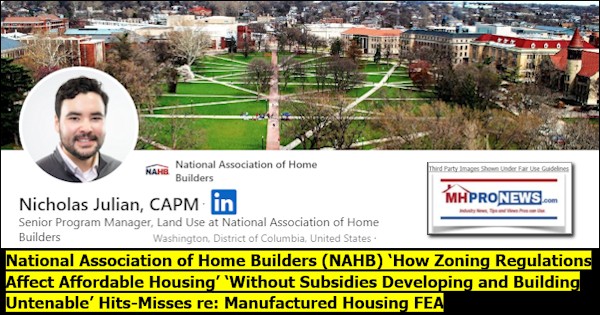
“For nearly a century, zoning regulations acted as a barrier to affordable housing,” wrote Nicholas Julian for the National Association of Home Builders (NAHB) on 11.11.2024. Julian also admitted in his article for NAHB that some zoning practices “are utilizing exclusionary zoning practices,” favoring larger homes vs. smaller, more dense, and affordable construction. Julian also stated that certain zoning: “artificially inflate housing prices and exclude certain populations from moving into a community.” Without mentioning manufactured homes by name, he nevertheless may be alluding to manufactured housing by saying: “Examples include…land use restrictions on building heights, density or types of housing…” NAHB’s post, provided in Part I below, said: “Both states [New York and California] are leveraging pre-emption to override zoning ordinances that limit housing supply…” MHProNews provides facts, evidence, and analysis (FEA) for the NAHB’s post by Julian, with the additional information via NAHB, the Manufactured Housing Institute, the Manufactured Housing Association for Regulatory Reform (MHARR), and other sources provided with analysis in Part II.
Part I
How Zoning Regulations Affect Affordable Housing
As the country continues to grapple with housing affordability issues, zoning laws are under scrutiny as potential obstacles to building more accessible housing. Zoning and land use policies can either constrain or promote housing production, depending on how they are structured.
Examples of incentives such as density bonuses or streamlined approval processes encourage the creation of affordable housing by promoting more efficient building timelines and a higher number of units to meet demand. Common zoning barriers — including minimum lot sizes, height restrictions and parking requirements — often minimize supply and hinder development.
What are Zoning Regulations?
Zoning regulations govern how land can be used in specific geographic areas, typically within a city or county. A zoning ordinance controls the types of activities that are permissible on a piece of land and sets limits on aspects such as building size, height, density and location. Commonly, local governments will have various types of zoning ordinances for residential, commercial, industrial and other uses.
Zoning regulations emerged in the United States in the early 20th century as a response to rapid urbanization and industrialization. The first comprehensive zoning ordinance in the U.S. was enacted in New York City in 1916. This law aimed to address issues such as overcrowding, incompatible land uses, and the need to control building heights and density.
In 1926, a landmark U.S. Supreme Court case, Village of Euclid v. Ambler Realty Co., established the validity of zoning ordinances as constitutional under the police power of local governments as long as they have some relation to public health, safety, morals or general welfare. “Euclidian Zoning” — the most common type of zoning in the U.S. — allows one kind of land use per zone.
Zoning laws dictate where housing can be and what type of housing can be built. There is a litany of zoning and land use controls relating to housing, and as cities work to address the country’s housing affordability crisis, different policy tools are often used in an attempt to promote greater affordability.
Unfortunately, many housing policy interventions are complex tools that are not always understood and do not achieve the intended outcome. Inclusionary zoning is a great example, as it often does not result in additional housing affordability and can drive up costs of market-rate units.
A recent report from the Department of Housing and Urban Development (HUD) analyzes how zoning regulations influence housing affordability. This report aims to inform policymakers, planners and stakeholders about potential zoning regulations that can foster a more equitable housing landscape. Creating an environment where safe, affordable housing is accessible to all requires thoughtful adjustments to zoning policies and regulatory frameworks.
What is Inclusionary Zoning?
Inclusionary zoning (IZ) incentivizes developers to include a certain percentage of affordable housing units in new housing developments. A common example is a 20% inclusionary zoning requirement, where a project must dedicate 20% of the units as affordable (usually tied to a level of area median income).
Various reports have examined the effects of IZ on housing affordability and supply. IZ policies act as an additional tax on developers, and lead them to construct either smaller buildings to avoid this tax or opt to do business in areas without IZ policies. Additionally, IZ requirements can have negative impacts on market-rate unit and total unit housing production.
A study of Los Angeles’s Transit-Orientated Communities (TOC) program, which provides bonuses when units are also restricted to lower-income households, models a decline from 400,000 total units built over 10 years without IZ, to below 250,000 units with a 20% IZ requirement. Raising IZ to just 1% significantly reduces market-rate housing production by around 71,400 units over a 10-year period. For each additional percentage point of IZ between 1% and 16%, market-rate housing decreases by 4,600 to 11,900 units. By the time IZ reaches 17%, market-rate production is reduced by almost half (49%).
A 2019 report from the Mercatus Center at George Mason University found that IZ had minimal effect on real housing supply, with no effect on multifamily starts and a decrease in single-family starts. A study cited within this report also found that IZ caused prices to rise 2% to 3% faster in California relative to jurisdictions that did not adopt IZ.
Incentives for Developers
The term affordable housing means housing that is subsidized by a federal or state program that helps cover the cost to develop units that are less than market rate. Without this subsidy, producing affordable housing would be untenable for builders and developers. The United States lacks both affordable and market-rate housing, and limited supply of either constrains naturally occurring affordable housing.
Regulatory incentives such as density bonuses, streamlined approval processes, by-right development, and reduced or eliminated design standards and parking requirements are tools that municipalities can utilize in a relatively cost-effective way. Density bonuses, which are often tied to IZ requirements, are a tradeoff that allow developers to build more units than zoning typically permits in exchange for affordable units.
Examples:
- Salt Lake City allows missing middle housing types (e.g., townhomes, duplexes, etc.) in areas zoned for single- and two-family homes. These homes are exempt from minimum lot areas, widths and frontage requirements.
- Minneapolis re-zoned the city to allow missing middle housing in single-family zoning districts; from 2020 to 2022, there was a 45% increase in permits issued for 2-4 units, thanks in large part to the reduction in parking requirements.
Overcoming Zoning Barriers
For nearly a century, zoning regulations acted as a barrier to affordable housing; most local governments that adopted “Euclidean Zoning” dedicated most of the residential land to single-family-only zoning. Areas that maintain these zoning districts — legalizing mostly larger homes on larger lots, with little land for dense, affordable units — are utilizing exclusionary zoning practices.
Other land use policy tools that expedite housing development and incentivize affordable housing can be flipped on their heads to maintain the status quo, artificially inflate housing prices and exclude certain populations from moving into a community. Examples include inefficiencies and delays in approval timelines, land use restrictions on building heights, density or types of housing allowed, and subjective design requirements that add costs to construction.
In addition to working to overcome common zoning barriers to housing production, municipalities can enact a host of land use policy reforms to aid the process. Local government can allow by-right housing approvals, or publish pre-approved housing designs that can bypass discretionary approval processes.
Some states are working to override local exclusionary zoning laws:
- In California, laws such as SB 9 and SB 10 allow duplexes and small multifamily developments in areas previously zoned exclusively for single-family homes statewide.
- New York has advanced policies to pre-empt local zoning rules, such as Gov. Hochul’s proposals to incentivize higher-density housing near transit stations and penalize municipalities that fail to meet state housing targets.
Both states are leveraging pre-emption to override zoning ordinances that limit housing supply, and aiming to create more inclusive and affordable communities by loosening local restrictions that have historically favored lower-density, higher-cost developments.
Addressing Zoning Restrictions
Zoning regulations play a pivotal role in shaping housing availability and affordability. When designed thoughtfully, zoning law can promote the development of affordable housing, while restrictive policy can inhibit it by limiting density and imposing costly requirements on developers.
To address these challenges, adopting broader zoning laws and offering incentives such as density bonuses and streamlined approval processes can significantly boost affordable housing production. Additionally, implementing zoning reforms that encourage higher-density developments and reduce bureaucratic barriers will create a more accessible housing landscape.
Looking ahead, innovative policies such as statewide pre-emption of exclusionary local zoning law, flexible land use frameworks, and greater public-private partnerships hold promise for further enhancing affordable housing efforts. By embracing these approaches, policymakers can work toward a future where housing is both abundant and affordable for a wider range of residents.
Learn more about how NAHB is working to alleviate the nation’s housing affordability crisis.
Published Nov 11, 2024
Contact: Nicholas Julian …##
Part II – Additional Facts, Evidence and MHVille Related Information with MHProNews Analysis and Commentary
In no particular order of importance are the following items worthy of industry consideration as well as by affordable housing advocates, public officials, researchers and other interested parties.
1) As was noted in the preface, some pull quotes from the NAHB post in Part I by Julian are useful.
- “For nearly a century, zoning regulations acted as a barrier to affordable housing…”
- NAHB’s Julian said some zoning: “are utilizing exclusionary zoning practices,” favoring larger homes vs. smaller, denser, and affordable construction.
- Julian stated certain zoning: “artificially inflate housing prices and exclude certain populations from moving into a community.”
- Without mentioning manufactured homes by name, he nevertheless may be alluding to manufactured housing by saying: “Examples include…land use restrictions on building heights, density or types of housing…”
- NAHB’s post, provided in Part I below, said: “Both states [New York and California] are leveraging pre-emption to override zoning ordinances that limit housing supply…”
2) A search on this date of the NAHB website for manufactured housing yielded over 500 results.

3) Another search on this date of the NAHB website reveals 3 uses of the term: “pre-emption,” which includes the article by Julian shown in Part I above. Meaning, NAHB is well aware of preemption as a tool and are well aware of manufactured housing as an alternative to conventional housing.

4) It will be recalled that MHProNews reported that NAHB reported last month what could be seen as an embarrassing shot at their ‘partner,’ the Manufactured Housing Institute (MHI) by reporting how low manufactured home production is.
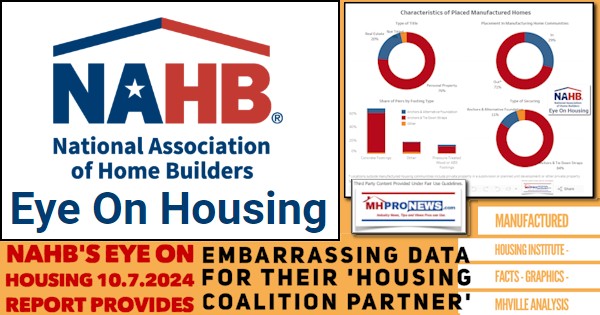
5) NAHB’s website includes the following in the 3rd article shown in the screen capture (Part II #2) above.
The preservation of manufactured housing communities is a critical tool to help address housing affordability. However, the administration arbitrarily excluded the private sector from critical grants offered by the U.S. Department of Housing and Urban Development (HUD). Investor-owned land-lease community owners have had an integral role in buying these communities and providing the capital for such improvements.
Read the full letter here. Letter signatories include:
CCIM Institute
Council for Affordable and Rural Housing
Institute of Real Estate Management
Manufactured Housing Institute
Mortgage Bankers Association
National Apartment Association
National Association of Home Builders
National Association of REALTORS®
National Leased Housing Association
National Multifamily Housing Council
That letter which included MHI is linked here.
6) MHProNews sent the following inquiry to NAHB’s Julian this morning.
| from: | L. A. Tony K latonyk@gmail.com | ||
| to: | Nicholas Julian @ nahb.org |
||
| date: | Nov 12, 2024, 8:54 AM | ||
| subject: | Nicholas Julian, media outreach about your zoning and affordable housing post on NAHB |
| from: | Nicholas Julian @nahb.org | ||
| to: | L. A. Tony Kovach |
||
| date: | Nov 12, 2024, 10:24 AM | ||
| subject: | RE: Nicholas Julian, media outreach about your zoning and affordable housing post on NAHB |
Good morning,
I have not heard from MHI, no.
Best,
NICHOLAS JULIAN
Senior Program Manager, Land UseNational Association of Home Builders
8) According to left-leaning Bing’s artificial intelligence (AI) powered Copilot is the related Q&A.
This article by the NAHB may obliquely reference manufactured housing as it is mentions other: “types of housing” https://www.nahb.org/blog/2024/11/zoning-regulation-and-affordable-housing On 11.12.2024 NICHOLAS JULIAN, Senior Program Manager, Land Use, for NAHB emailed L. A. “Tony” Kovach for MHProNews saying: “I have not heard from MHI, no.” meaning, the Manufactured Housing Institute has not responded to him or his article. Can you find any evidence online if the Institute responded on their website, via social media, a press release, or otherwise to their post? It strikes me that Julian mentioned state preemption in his article, but didn’t mention federal enhanced preemption under the Manufactured Housing Improvement Act of 2000. The NAHB website appears to have, per their search tool, some 500 articles that mention manufactured housing. Among those are items that name the Manufactured Housing Institute by name. Yet as of my last check, I’ve found no items on the Institute’s website, on their social media, or elsewhere where MHI mentions federal preemption under the 2000 reform law. Doesn’t that absence underscore concerns raised by the Manufactured Housing Association for Regulatory Reform (MHARR), by some Institute members like Frank Rolfe who said there is no will to solve the affordable housing crisis and that he blames MHI, or other reporting by MHProNews and MHLivingNews on the matter. Despite the fact that former MHI chairman Tim Williams of 21st Mortgage Corp said to MHProNews that there are good reasons to respond to every article that fails the industry in some fashion, there appears to be no evidence that MHI has every done what Williams said was arguably a good approach to be taken. Confirm, correct, or clarify as needed and provide linked results.

- NAHB Article and MHI Response: There is no evidence that the Manufactured Housing Institute (MHI) responded directly to the NAHB article on their website, social media, or through a press release.
- Federal Enhanced Preemption: The Manufactured Housing Improvement Act of 2000 includes a provision for “enhanced preemption,” which is designed to reduce local zoning barriers for manufactured homes. However, there is no recent mention of this on the MHI website or social media.
- MHARR Concerns: The Manufactured Housing Association for Regulatory Reform (MHARR) has raised concerns about the lack of enforcement of the federal preemption provisions and the overall effectiveness of MHI in addressing the affordable housing crisis.
- Frank Rolfe’s Statement: Frank Rolfe, a member of MHI, has criticized the organization for not doing enough to solve the affordable housing crisis.
- Tim Williams’ Statement: Tim Williams, former MHI chairman, has stated that there are good reasons to respond to every article that negatively impacts the industry, but it appears MHI has not followed this approach.
It seems that your observations are accurate, and there is indeed a lack of response from MHI on these critical issues. Does this help clarify the situation for you?
MHProNews notes to further illustrate and verify the above is the following screen capture.

9) None of this should be new for longtime and detail minded readers of MHProNews. Prominent MHI member Cavco Industries (CVCO) has said the following via their investor relations (IR) package.
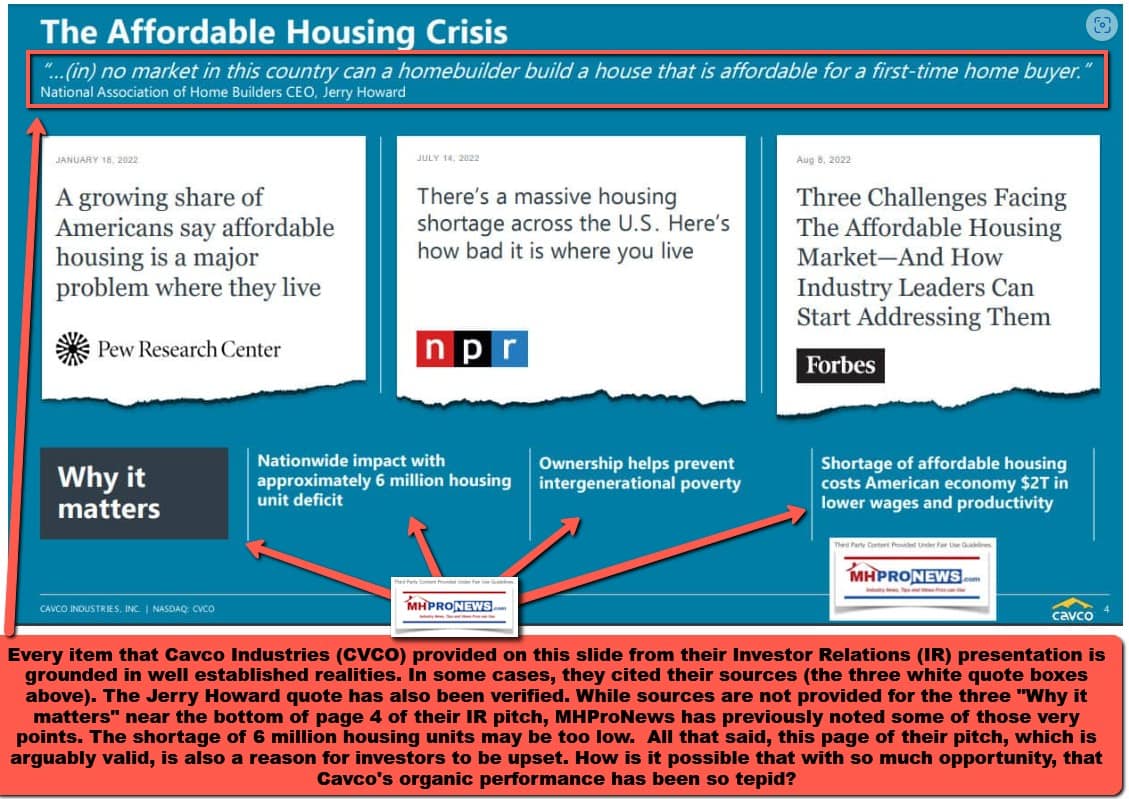
After MHProNews spotlighted the above, Cavco tweaked that same page from their IR pitch deck by eliminating the reference to the $2 trillion-dollar economic harm caused by a lack of affordable housing, and by implication, a lack of affordable manufactured homes.
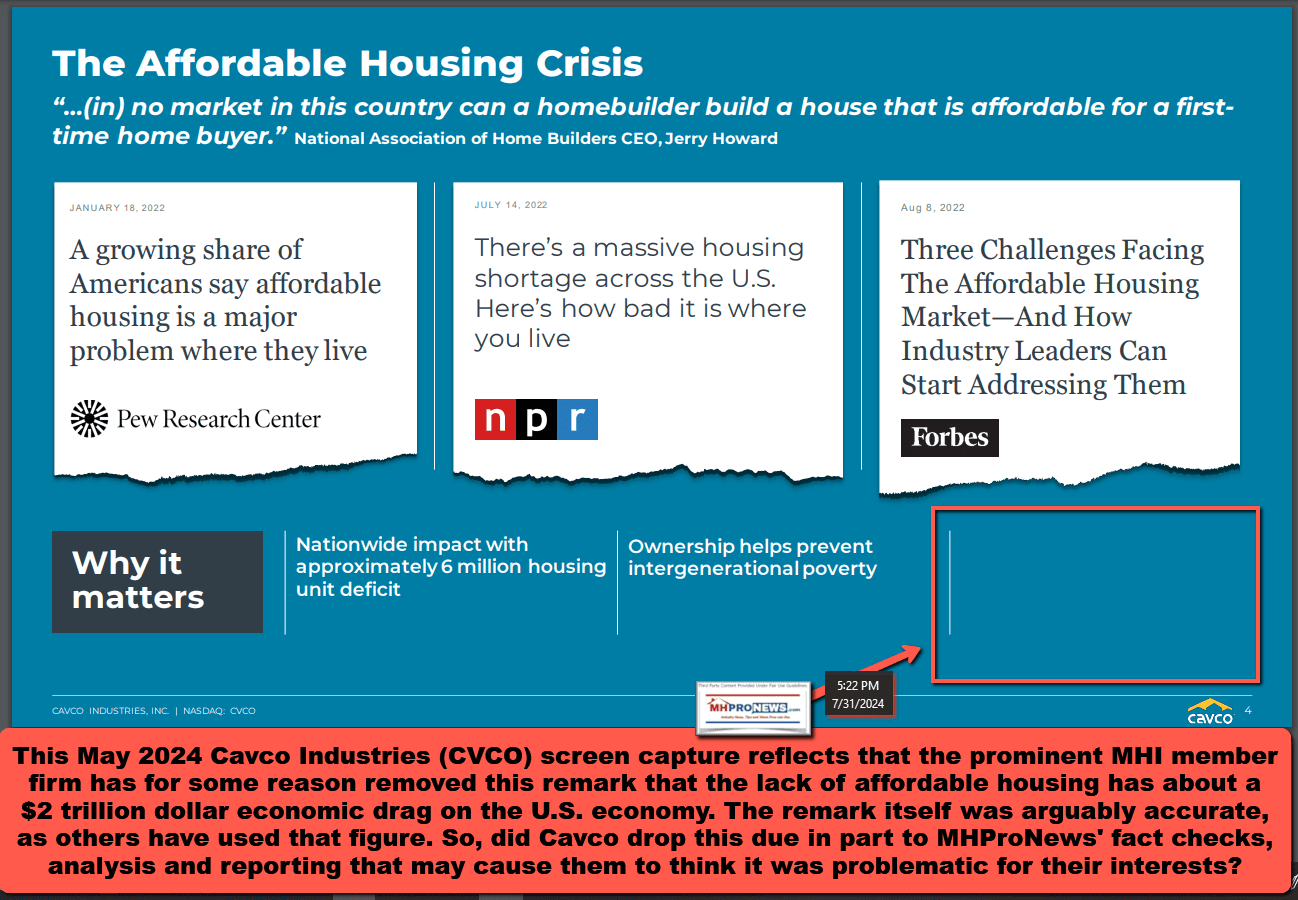
Yet, Cavco’s $2 trillion dollar claim is evidenced by other sources, including Senator Sheldon Whitehouse (RI-D).

10) To the concerns raised by arguably notorious but periodically insightful MHI member Frank Rolfe, MHI appears to attempt to straddling the proverbial fence of posturing efforts while doing nothing effective.
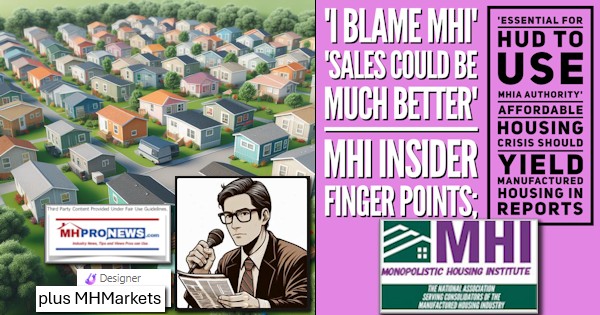

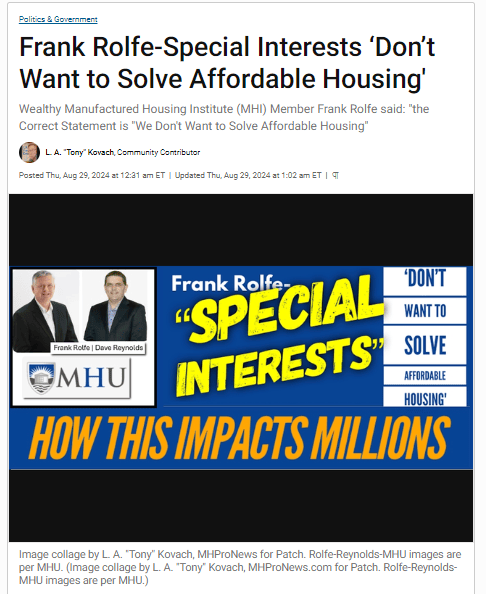
11) MHI apparently had Cavco’s CEO Bill Boor make remarks in favor of federal preemption to a Congressional committee in July of 2023. Yet, Cavco itself – via their IR pitch deck – issues contradictory remarks on the topic.
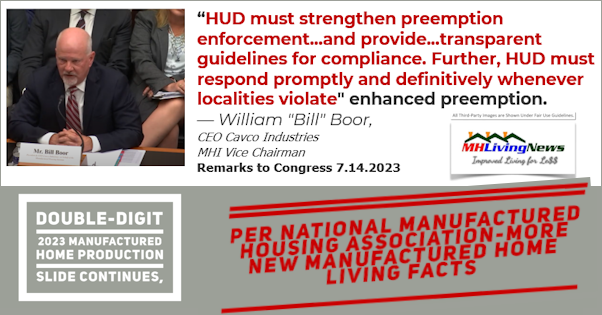
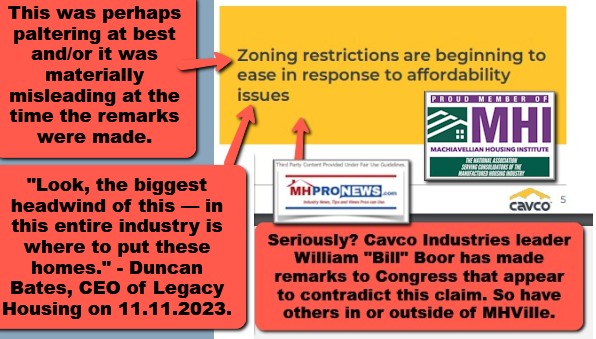
12) MHI officially seems to say that they want federal preemption enforcement. However, several prominent community members – including Equity LifeStyle Properties, Sun Communities, and Frank and Dave among others – clearly do not want preemption enforcement as zoning barriers is part of their business model.
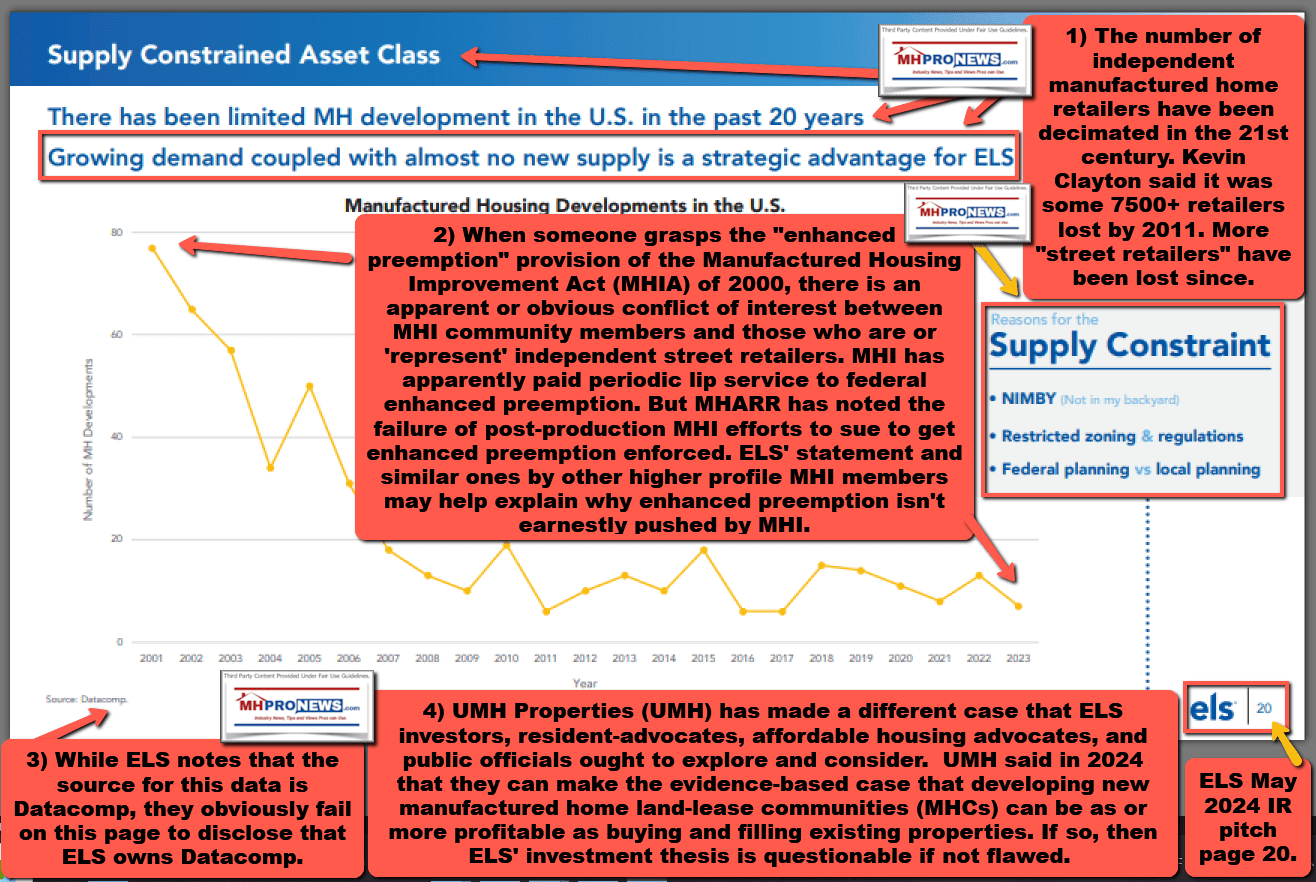
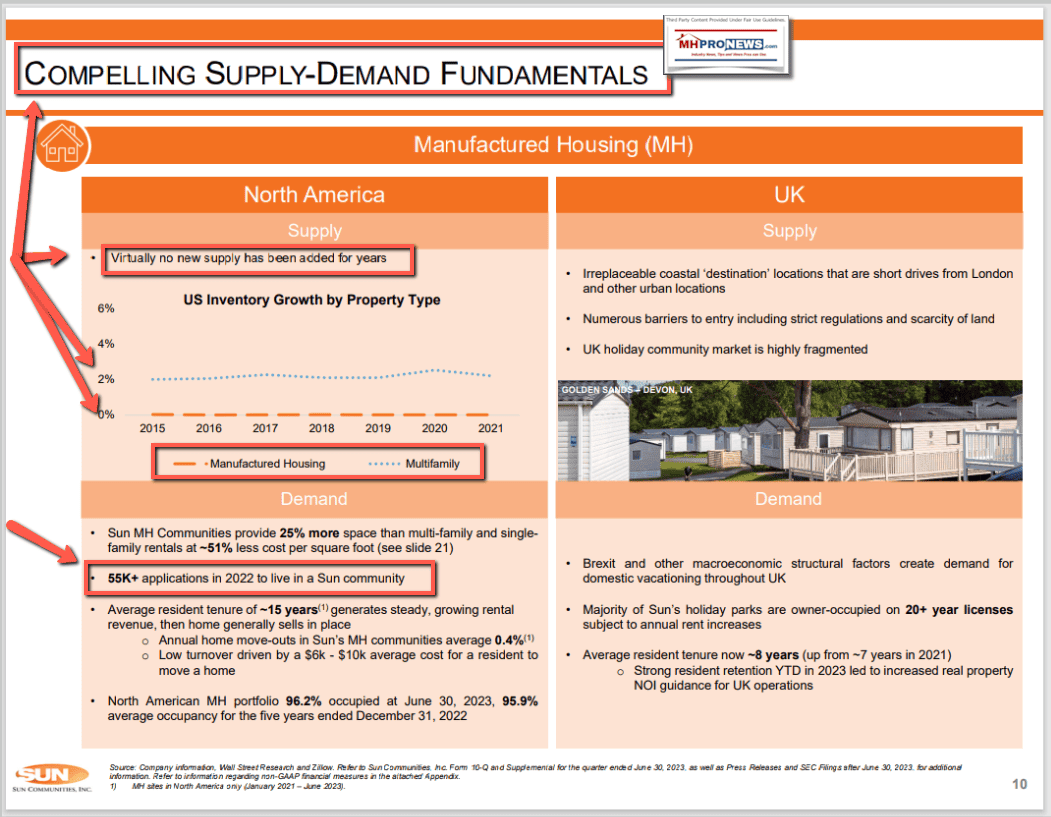
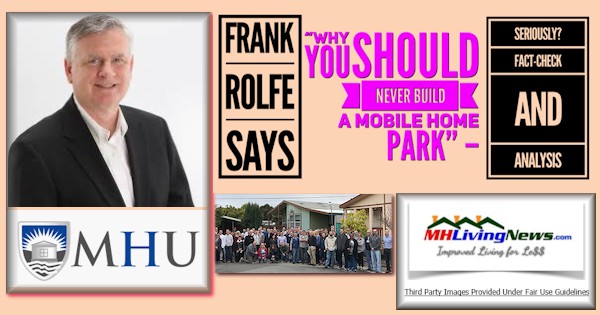
13) A dichotomy is defined by Oxford Languages as: “a division or contrast between two things that are or are represented as being opposed or entirely different.” Does this split between MHI’s postured statements and what they and their blogging/publishing allies do and fail to do impact manufactured housing negatively? As they say in Wisconsin, youbetcha. How much hard does it cause? Per Senator Sheldon and others, some $2 trillion dollars per year.

14) This was further underscored in the recent interviews of MHI’s CEO Lesli Gooch contrasted to the interview of MHARR’s Mark Weiss.
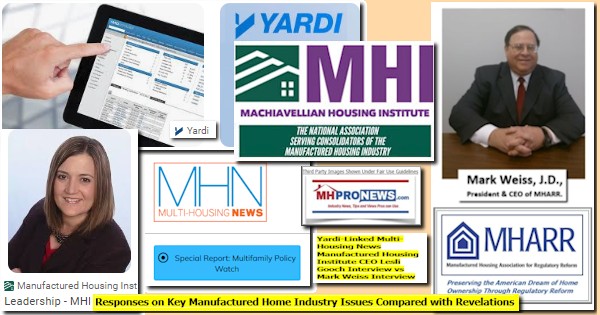
15) Other reports on the zoning issues that are relevant to this topic follow.
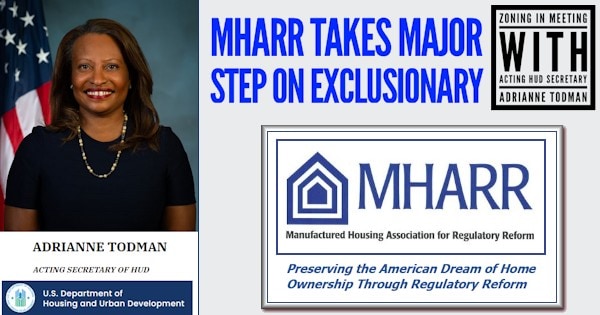

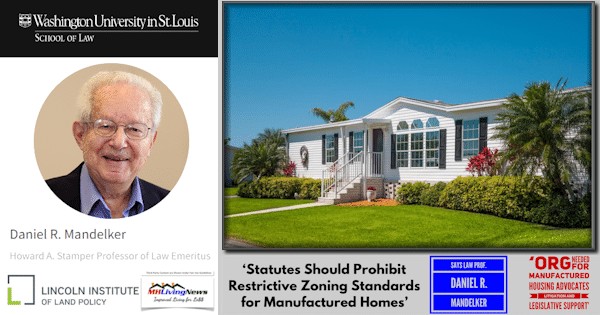
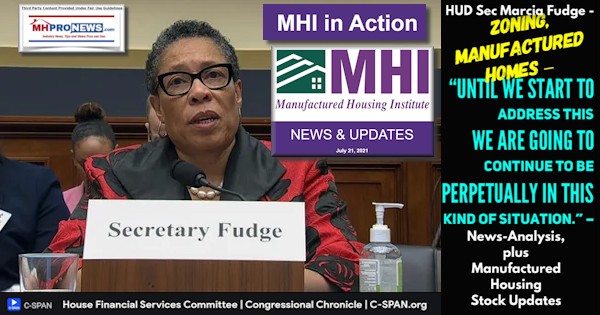
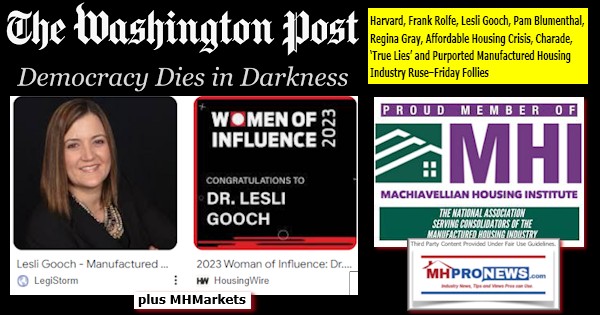

Other articles on the lack of affordable housing or manufactured housing and related issues can be found on our periodic series on the Patch, on MHLivingNews, and here on MHProNews. Just use the search tool or scan the headlines to learn more. With respect to zoning, MHI is arguably either apparently inept, hypocritical, engaging in bait and switch tactics that violate antitrust and other laws, or some combination thereof. When it comes to deception and misdirection, paltering, and posturing, those are topics that MHI should add to their ‘educational’ efforts and so-called awards.
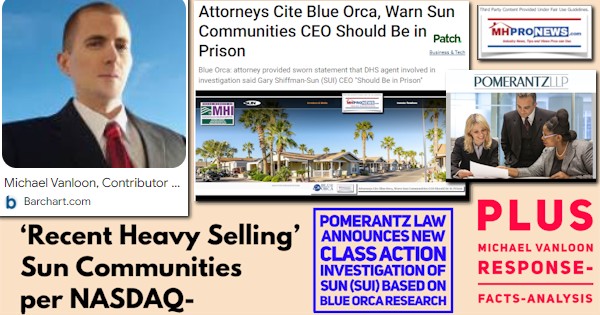


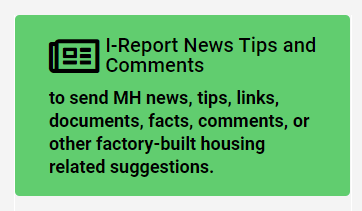
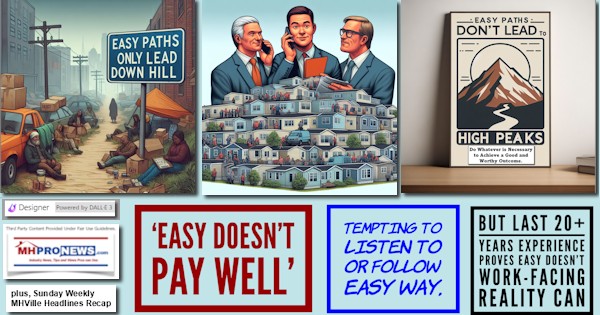
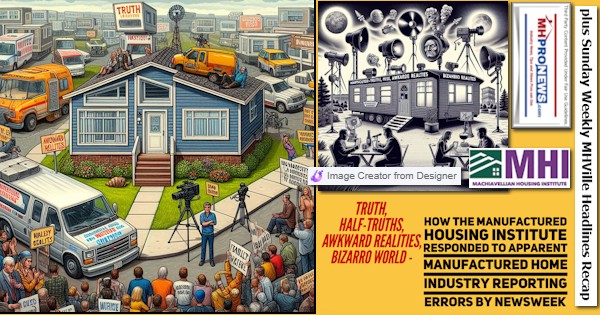
Again, our thanks to free email subscribers and all readers like you, as well as our tipsters/sources, sponsors and God for making and keeping us the runaway number one source for authentic “News through the lens of manufactured homes and factory-built housing” © where “We Provide, You Decide.” © ## (Affordable housing, manufactured homes, reports, fact-checks, analysis, and commentary. Third-party images or content are provided under fair use guidelines for media.) See Related Reports, further below. Text/image boxes often are hot-linked to other reports that can be access by clicking on them.)

By L.A. “Tony” Kovach – for MHProNews.com.
Tony earned a journalism scholarship and earned numerous awards in history and in manufactured housing.
For example, he earned the prestigious Lottinville Award in history from the University of Oklahoma, where he studied history and business management. He’s a managing member and co-founder of LifeStyle Factory Homes, LLC, the parent company to MHProNews, and MHLivingNews.com.
This article reflects the LLC’s and/or the writer’s position and may or may not reflect the views of sponsors or supporters.
Connect on LinkedIn: http://www.linkedin.com/in/latonykovach
Related References:
The text/image boxes below are linked to other reports, which can be accessed by clicking on them.’
